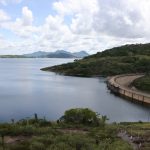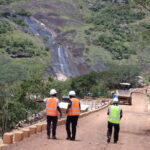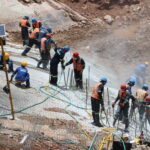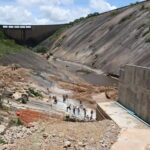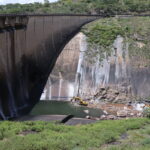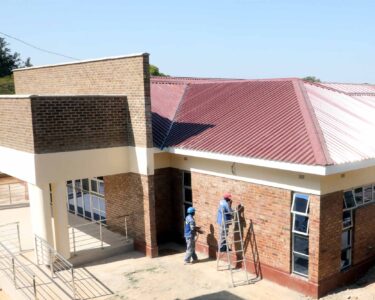… New 5 MW generation station to come on stream in October 2023
Masvingo Province has not only used devolution funds to great effect, it has Zimbabwe’s “best kept secret” tucked 41.5 km away from Masvingo city, at the Lake Mutirikwi Dam wall. A new hydro project there should entice you to go and see one of the most scenic views Zimbabwe has to offer. Baffour Ankomah reports.
Many people have heard of the famous Great Zimbabwe ruins, 27 km southeast of Masvingo city. But only a few know about the truly stunning beauty of its nearest neighbour across the road, the Mitirikwi Dam and its environs. They take the breath away.
If you have not gone to the Mitirikwi dam wall and seen the spectacular panoramic view of the blue lake spreading as far as the eye can see, your sight only broken by the undulating dark mountains in the far distance arranged like acorns overlooking the shimmering waters of the lake, then you haven’t seen beauty yet.
You must pay anything to go and see it. No postcard photo can beat the majesty of this place. It is the kind of beauty that forces you to say “wow”.
And “wow” we all said as we approached what must be Zimbabwe’s best kept secret, pristine as they come.
The day was 15 February 2023. Our team of Brick by Brick editors that has been travelling throughout the country for 7 months looking at what the Second Republic has achieved in President Emmerson Mnangagwa’s first time, had been taken to see one of the most beautiful primary schools in the environs of the Great Zimbabwe ruins, the Chirichoga Primary School.
It was still mid-morning. We would see the ruins itself later in the day. But from Chirichoga, we were taken to see the site of the Lake Mitirikwi Dam wall, 14.5 km away from the turn-off to Great Zimbabwe. Wow, what a sight!!
The tail end of the lake’s waters can be seen from on top of Great Zimbabwe’s Acropolis or Hill Complex, where the kings lived. That is just across the road from the ancient ruins.
But to see the dam site, you have to travel through the picturesque green woods on a twisting tarred road that takes you slowly up a mountain which would later be split into two by the Mitirikwi River as it makes its way languidly from the dam wall after leaving almost all of its waters in the lake.
The river runs deep down a gorge, surrounded on both sides by steep, bald, dark granite mountains on whose surfaces run streamlets of pristinely clean white water. Wow, you say again.
And then you arrive at the dam wall, curved by the engineers who took 2 years between 1958 and 1960 to build it. It is only when you look up from the dam’s concrete wall, darkened by age, and your eyes slowly take in the panoramic view of the blue waters of the lake and the mountains far in the distance, that your chin hit your chest. Breathtaking is the word. No better scene has any great painter painted in the world!
You sit down and shake your head, not in an unbelieving manner, but at the sheer quantum of God’s gift to Masvingo city and province. ZimFieldGuide.com tries to convey the message: “There are dramatic views up the length of Lake Mutirikwi from the heights of St Andrew’s Chapel,” it says.
But why has nobody told the crowd about the “dramatic views” of the Mutirikwi Dam site? I have been going to Great Zimbabwe for about 10 times since 2002, but no tourist guide at Great Zimbabwe has told me about the stunning views of the Mutirikwi Dam site. Many tourists, and even millions of Zimbabweans themselves, simply don’t know or are not told about the scenic views of Lake Mutirikwi, so they end up at Great Zimbabwe and off they go home. But the environs of the Mutirikwi Dam are a tourist delight.
The dam, built by the colonialists, via the South African construction giant, Concor, was formerly known as the Kyle Dam and the lake, Lake Kyle. It is said that the lake and dam was named after “Kyle Farm which occupied most of the land required by the lake, which in turn was named after the Kyle district of Scotland from which the pioneer of the Lowveld, Tom Murray MacDougall, came originally”.
Thank God, after Zimbabwe’s independence, the descendants of the original owners of the country changed Lake Kyle and Kyle Dam to Lake Mutirikwi and Mutirikwi Dam.
Mutirikwi happens to be the largest of the rivers whose waters form the lake. The other rivers are: Mucheke, Machaba, Popoteke, Umpopinyani, Makurumidzi, Shagashi, Mbebvi and Matare. The lake, according to records, covers 90 sq km over a surface area of 91,000 hectares with a long shoreline of 240 km. The curvy dam wall is 63 metres high with a base of 7 metres thick. It is an engineering feat.
Constructed to act as a reservoir to irrigate the vast citrus and sugar estates downstream in the Lowveld, specifically at Chiredzi and Triangle, Lake Mutirikwi was Zimbabwe’s largest inland lake until the Tugwi Mukosi Dam was completed in December 2016 and commissioned in May 2017.
Yet, Tugwi Mukosi may have taken the record of size from Mutirikwi but not its sheer beauty. It is here that a consortium of pension companies and their business partners have banded together to build a 5 MW hydro project out of the waters that are allowed to flow out of the dam.
Great Zimbabwe Hydro
The development is being done by Great Zimbabwe Hydro, a consortium of pension funds led by Old Mutual, and MoreHydro Power, and Frantile Energy from Denmark – forming what is known in the business as an “independent power producer”.
The project is being funded by Mol Power Hydro Electric, Frontier Investment Management (Frontier Energy), and Old Mutual. The civil works contractor is JRG Jabulani Kuphela, and the design consultant is VS Consulting from Sri Lanka.
When Brick by Brick visited on 15 February 2023, the development was at 60% completion. “All things being equal, we will complete by October 2023,” the youthful site engineer, Austern Chiboora, 37, told our team.
Flanked by his colleague, Pride Dube, 39, an equally youthful environment, health, and safety officer, Chiboora continued: “We are developing a mini hydro power plant with a capacity of 5 MW. We are using the dam to do the power plant. It will be the first of its kind in terms of independent power producers in the country.
“This dam was mainly designed to provide water to irrigate the Chiredzi sugar cane plantations downstream. So what they normally do is to release water for Chiredzi. What we want to do is to use the water going to Chiredzi to generate electricity before the water continues its journey to the beneficiaries in Chiredzi. Normally from here, the water goes to another dam downstream before reaching Chiredzi.”
To cost US$14.5 million at completion, the project started on 9 March 2022. It employed 180 workers during the first phase, and 105 during the second phase.
Over 50% of the workers came from the local community. The numbers are expected to rise as more work comes in the second phase. “It can reach as high as 250 for this phase, on top of the 180 of the first phase,” Engineer Chiboora said.
He told the Brick by Brick team about some of the challenges they had faced constructing the hydro station. “This terrain we are working on is a dangerous one,” he said. “It is steep, and walking on granite after rain showers, makes it slippery. The working conditions are very hazardous but I am glad to say we haven’t had any deaths on this project. We have had near accidents, but no deaths.”
When Brick by Brick visited, there were heavy machines right in the riverbed down below, breaking up huge dark boulders to make way for the generation pipes to be laid.
Our team was intrigued by the youthfulness of the engineers leading the project. Asked why he chose to stay in Zimbabwe while people of his age emigrated for greener pastures abroad, Chiboora answered simply: “To develop my country”.
For a young man, Chiboora, an engineering graduate of the National University of Science and Technology (NUST), Bulawayo, has had generous opportunities of working on some of the biggest projects in the country in recent years – the Victoria Falls Airport, RGM International Airport in Harare, and infrastructure developed by the Postal & Telecommunications Regulatory Authority of Zimbabwe (POTRAZ).
Asked what assurances he and his colleagues working on the hydro project would give the nation that what they are doing at the Mutirikwi Dam site meets international standards, Chiboora smiled and said:
“One reason why I took this job is that there are a lot of experts working on this project. They have done this job all over Africa, so they have vast experience and they are bringing that experience here, so that we, as Zimbabweans, will benefit from their experience to develop our country.
“So this project has many people from different countries working together – from China, Sri Lanka, Netherlands, Uganda, Kenya and elsewhere. So we interact with all those guys on this project. And the positions we have here means everything passes through us. We get to take all that knowledge and use it to the benefit of our country.”
Pride Dube, the EHS officer, another graduate from NUST, had similar sentiments. After graduating from NUST in 2007, he worked in various companies in Zimbabwe before going to South Africa briefly to work from late 2021 to July 2022, and then came back.
He assured the nation that though he and his colleagues may be youthful-looking, they have experience backing them. “The company I worked for in consultancy is one of the biggest in the country, so when you are in this position, you take all in. Normally when you get a project from start to end, you learn a lot. So I have done big projects from start to end and acquired all the skills.”
We asked him why he came back from South Africa when things are said to be greener there than in Zimbabwe. Dube answered: “As soon as you go out, you get the realisation that at the end of the day home is best. Before you go outside, you hear all sorts of nice things – the grass is greener outside. But when you go there, you realise that it is not as what people were saying. So I said, let me go home and work for my country. That’s where my family is, where all my social ties are.”
This forced my colleague and editor-in-chief of Brick by Brick, Munayaradzi Huni, to remind Dube of what his (Huni’s) father tells him. “My father always says to me: ‘You know my son, be careful of where the grass is green. It could be sewage.’”
Classic Huni.



